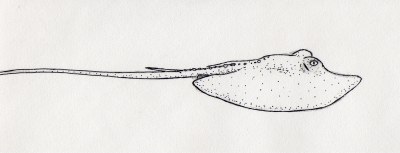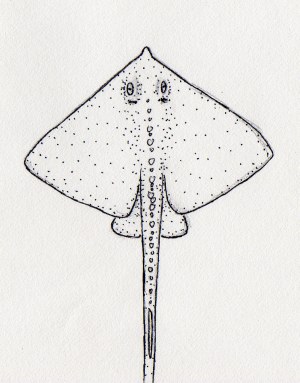Stingrays in GURPS
 The world's many species of stingrays are common inhabitants of tropical waters. They lie in wait on the sea floor, partially covered in sediment. Moving slowly along the ocean bottom, they detect potential prey using their electroreceptive sense in combination with touch and smell. Once found, prey is uncovered by jettting water from the mouth or with currents of water propelled by the pectoral fins.
The world's many species of stingrays are common inhabitants of tropical waters. They lie in wait on the sea floor, partially covered in sediment. Moving slowly along the ocean bottom, they detect potential prey using their electroreceptive sense in combination with touch and smell. Once found, prey is uncovered by jettting water from the mouth or with currents of water propelled by the pectoral fins.
Stingrays are docile and unagressive, but defend themselves if molested. Stingray jaws cause very little damage to humans, as they are mainly used for crushing shells. Their main line of defense is their sting, a saw-edged spine coated in venom that protrudes from the ray's tail. When greatly provoked, the stingray whips its muscular tail about. The sting can cause severe lacerations and deep puncture wounds. Worse, the sting is covered by a venom filled sheath. When striking, the sheath breaks and venom enters the wound. The venom of the sting causes severe and immediate pain, followed by nausea, tremors, pallor, delerium, fever, and progressive paralysis possibly culminating in heart failure or cesation of breathing. The venom also has a necrotizing effect, leading to tissue death in the vicinity of the sting wound. Each sting can only envenomate once, since once the sheath breaks no more venom is supplied to the sting. The sting can continue to deliver cuts and stabs, however. Stingray stings are periodically replaced, so the stingray's ability to deliver venom will eventually be regained.
The stingray uses its sting soley for self defense. Humans are occasionally stung when they step on a resting stingray when wading, or when a fisherman hooks a stingray and attempts to bring it on board his vessel. When wading, walking with a shuffling gait will prevent directly stepping on a stingray - just bumping the ray with the feet causes it to swim away rather than sting. People who step on a stingray are almost always stung in the foot or leg. Fishermen often come off much worse, getting skewered through the torso or even the vitals.
In game terms, the venom of a stingrays sting is broken down into four parts
- A neurotoxin. Neurotoxins cause lack of coordination, followed by progressive paralysis culminating in respiratory failure for severe envenomation. It takes time for neurotoxic venoms to percolate through the body and affect the nerves; the effects usually worsen for several hours to a day before recovery begins. In game terms, this is treated as "non-wounding" Fatigue damage that causes progressively worse symptoms as more fatigue is accumulated, beginning with DX penalties and progressing to full paralysis and finally respiratory failure. The "non-wounding" fatigue means that the fatigue accumulated for the neurotoxin has no effect except for determining when the symptoms take effect.
- A cardiotoxin. Cardiotoxins affect the heart, enough cardiotoxin causes cadiac failure. As with neurotoxins, cardiotoxins take a while to take effect. In game terms, this is treated as Fatigue damage that causes a heart attack as a symptom if the venom damage exceeds 1.5 FP. For simplicity, the nausea is also acounted for through the cardiotoxin as a symptom that occurs at 1/3 FP.
- A necrotoxin. Necrotoxins produce localized tissue death, resulting in swelling, inflamation, and a necrotic wound. As with the previous two varieties, necrotoxins take time to cause injury. The most severe injury occurs in the first several hours, but the wound continues to worsen for several days. This is treated in the game as HP damage to the hit location struck by the stinger.
- Immediate pain. A chemical is introduced into the wound which stimulates the pain nerves, resulting in debilitating pain lasting several hours. In game terms, this is immediate non-wounding toxic damage with symptoms of severe pain if the damage exceeds 1/3 HP. This damage heals quickly, every ten minutes counts as one day of healing (the reason this is not treated as fatigue damage is so that it scales properly with the size of the victim).
There is a chance that a stingray injury does not introduce venom into the wound at all. Roll a die, on a 14 or less, all effects of the venom occur. On a 15 or more, no envenomation occurs. Only roll once for all venom types. If the wound is not envenomated, the stinger is not "discharged" of its venom, and can still envenomate on a later strike.
Although the cardiotoxin and neurotoxin are resistable, a successful resistance roll will not stop further damage - another resistance roll must be made for each cycle regardless of how many were succeeded beforehand (in game terms, the Cyclic modifier is not halved, but Resistable is at full value). In order for the venom effects to properly scale with the victim's size, it is suggested that the Afflictions and Poisons house rules be used, where the victim gets a 3×SM modifier to HT rolls to resist the effects of envenomation. This is easy to implement in most games, since humans (SM 0) will not be affected and it can mostly be ignored. Optionally, you can also implement the rules where large margins of failure cause the victim to succumb more quickly (take more fatigue damage). This is realistic, but adds additional complexity which you may prefer to ignore.
Stingray venom is broken down by heat. Soaking a stung extremity in not-quite-scalding water for a hour gives a +4 to all subsequent HT checks to resist the venom.

Game Statistics
| choose a species:
|
|
Species
| tiny
0.5 kg
| small
1 kg
| moderate
4 kg
| medium
10 kg
| large
25 kg
| big
50 kg
| huge
100 kg
| giant
200 kg
| collosal
400 kg
| (optional)
enter weight (kg)
| T? | HR? | |
| |
The radio button entries in the table above give realistic sizes of the species of that row. If you want a specimen outside that range, enter the weight in kg manually.
Marking the T? checkbox will give you the stats in template form with all costs listed, otherwise you get a stat sheet as for a character.
Marking the HR? checkbox will print the information using all my house rules. Otherwise, the stats will be as compatable with plain vanilla GURPS as possible (although several custom advantages and disadvantages will be present, see my Traits page).
|
Back to Animalia
 The world's many species of stingrays are common inhabitants of tropical waters. They lie in wait on the sea floor, partially covered in sediment. Moving slowly along the ocean bottom, they detect potential prey using their electroreceptive sense in combination with touch and smell. Once found, prey is uncovered by jettting water from the mouth or with currents of water propelled by the pectoral fins.
The world's many species of stingrays are common inhabitants of tropical waters. They lie in wait on the sea floor, partially covered in sediment. Moving slowly along the ocean bottom, they detect potential prey using their electroreceptive sense in combination with touch and smell. Once found, prey is uncovered by jettting water from the mouth or with currents of water propelled by the pectoral fins.
